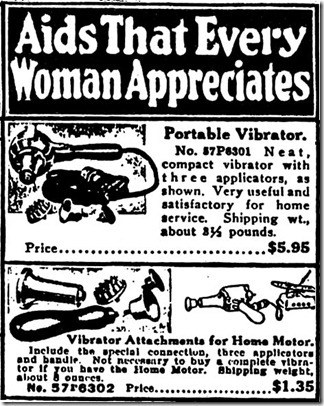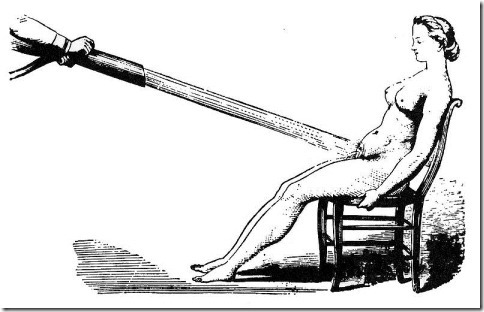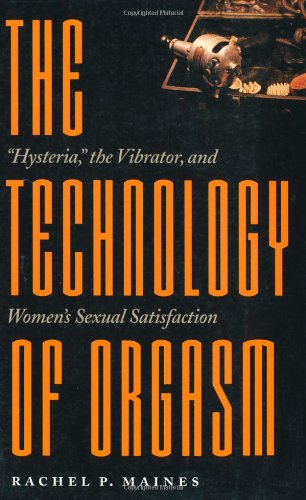For over 2500 years, the medical profession helped the large percentage of (well off) women suffering from hysteria by regularly inducing "hysterical paroxysm”, aka orgasm.
A lone University Professor wrote the book about vibrators, manual massage by physicians and midwifes, and promptly lost her University job.
-
Don’t miss part 1: The history of vibrators: (1) orgasms as medical therapy for hysteria
Batteries Not Included: A social history of the vibrator. |NYT
The electric vibrator was invented right after the electric sewing machine, fan, teakettle and toaster, and before the electric vacuum cleaner, the electric iron and the electric fry pan. Who knew that everyone cared so deeply about women’s pleasure? […]
In 1918 Sears, Roebuck & Company offered a vibrator attachment for a home motor that would also drive a churn, a mixer and a sewing machine. Two models of portable vibrators were described as ”Such Delightful Companions” in 1922. Still another advertisement promised, ”All the pleasures of youth . . . will throb within you.”
Alas, the invention of the vibrator had nothing to do with love in the afternoon or sexual liberation. It was originally a labor-saving device to help doctors give their female patients a ”hysterical paroxysm” — that is, an orgasm.
What in the world were doctors doing vibrating their female patients to orgasm? The simple answer is that their fingers got tired. The complicated answer is delivered in Maines’s short, stimulating, repetitive and occasionally frustrating book, ”The Technology of Orgasm: ‘Hysteria,’ the Vibrator, and Women’ s Sexual Satisfaction.”
The vibrator, Maines argues, is the last in a long line of devices and techniques that were used to combat hysteria. Beginning with Hippocrates and running through Galen, Avicenna, Paracelsus, Pare, Burton and Harvey, all the way up to the mid-20th century, doctors fought valiantly against this terrible disease. The trouble was that the disease they were fighting, Maines explains, was ordinary female sexual desire. The classic symptoms of hysteria — ”anxiety, sleeplessness, irritability, nervousness, erotic fantasy, sensations of heaviness in the abdomen, lower pelvic edema and vaginal lubrication” — are the symptoms of chronic arousal. NYT
2500 years of medical orgasm induction
As Forestus suggests here, in the Western medical tradition genital massage to orgasm by a physician or midwife was a standard treatment for hysteria, an ailment considered common and chronic in women. Descriptions of this treatment appear in the Hippocratic corpus, the works of Celsus in the first century A.D., those of Aretaeus, Soranus, and Galen in the second century, that of Aetius and Moschion in the sixth century,the anonymous eighth- or ninth-century work Liber de Muliebria, the writings of Rhazes and Avicenna in the following century, of Ferrari da Gradi in the fifteenth century, of Paracelsus and Pare in the sixteenth, of Burton, Claudini, Harvey, Highmore, Rodrigues de Castro, Zacuto, and Horst in the seventeenth, of Mandeville, Boerhaave, and Cullen in the eighteenth, and in the works of numerous nineteenth-century authors including Pinel, Gall, Tripier, and Briquet.2 Given the ubiquity of these descriptions in the medical literature, it is surprising that the character and purpose of these massage treatments for hysteria and related disorders have received little attention from historians.
 Millennia of medical orgasm induction, and it all stayed below the radar and remained quite unknown.
Millennia of medical orgasm induction, and it all stayed below the radar and remained quite unknown.
The authors listed above, and others in the history of Western medicine, describe a medical treatment for a complaint that is no longer defined as a disease but that from at the least the fourth century B.C. until the American Psychiatric Association dropped the term in 1952, was known mainly as hysteria.3
Before vibrators, women got hydrotherapy with water pressured by a few meters of gravity.
The famous Father Sebastien Kneipp, another European hydropath, set great store by the use of pumped water aimed at the pelvis as a treatment for female complaints.25
In Europe women were very happy with their hydrotherapy.
used the Priessnitzian douche, a gravity-powered fall of water from a cistern eighteen feet overhead. Lane, evidently in awe of women’s enthusiasm for the effects of hydrotherapy, mentions a lady who took the douche in the form of Niagara Falls, a sixty-foot fall at that point, and remarked, with some understatement, that "the Water Cure commends itself to the ladies."
W. B. Oliver, writing in the prestigious London medical journal Lancet in 1896, said of hydriatic massage that "the mechanical agency of percussion and vibration" of the water was modified by its temperature, so that when the jets of water strike the surface of the skin or "when it is applied in the form of a traveling douche accompanied by a vibratory form of massage, the vasomotor system is much more powerfully affected than by any form of still bathing."31
American doctors were concerned about the professional dignity:
He had reservations, however, about what he called "local irrigation" to relieve pelvic congestion in women, not because he thought it ineffective, but because he deemed it a threat to the decorum of the attending physician: patients stood in front of the doctor "receiving the column of water alternately, or as circumstances dictate, upon the spine and anterior surface of the body-a procedure somewhat startling to the Anglo-American sense of propriety, and scarcely in accord with our notions of professional dignity."26
Horseback riding also helped to get women’s juices going to cure them from hysteria
Another English spa of the second half of the nineteenth century provided horseback exercise, a traditional treatment for hysteria, to its women patients as an adjunct to hydrotherapy.28
No water therapy for men?
The reported enthusiasm of women for the douche is not surprising. A jet of pumped water aimed at the male genitalia is more likely to produce pain than pleasure, but the use of water as a female masturbatory method is well documented, although in this century it is apparently employed only by a minority.
It is interesting that there is no major concern with the male orgasm. Easily available orgasms for males might reduce tension, increase happiness, induce relaxation, take the edge off men’s harassment, and even reduce rape. In spite of this being a difficult project to get funding for, there probably is some research . I would be grateful for people to provide me links to such research.
Medical induction of orgasm is not prostitution?
In this text it is quite clear that women who need clitoral stimulation to reach orgasm are thought to be making unfair and unreasonable demands on their male partners, and that life would be simpler for all concerned if they would simply adjust to the androcentric model and have their orgasms vaginally. Lowen wrote at a time when it was no longer possible to simply hand off the job of producing orgasm to a physician or midwife. When the one-to-one confrontation cannot be avoided, Lowen expects the woman to yield.
This raises another question about orgasmic treatment as a medical procedure: its parallels with prostitution. There have been many arguments, historical and modem, regarding whether it should be legal for women and men to sell the service of producing orgasm. Some feminists in this and previous centuries have argued that there cannot be prostitution without systematic degradation of its practitioners.3 In the case of Western physicians, the legal question apparently never arose, although, as we have seen, there was some controversy within the profession as to the propriety of vulvular massage. Physicians, unlike prostitutes, did not lose status by providing sexual services, in part because the character of these services was camouflaged both by the disease paradigms constructed around female sexuality and by the comforting belief that only penetration was sexually stimulating to women. Thus the speculum and the tampon were originally more controversial in medical circles than was the vibrator. The aura of respectability that physicians cast over their provision of sexual services suggests that the task of producing orgasm is not in itself demeaning; performing it did not cause loss of caste for its elite practitioners, who were capable of disguising its earthy character.
What is hysteria?
Unofficially, a host of inoffensive synonyms for “hysterical” have appeared: functional, nonorganic, psychogenic, medically unexplained.
“Medically unexplained” and “functional” encompass a broader swath of distress than just conversion disorder — by some accounts, patients with medically unexplained symptoms account for up to 40 percent of all primary care consultations. But clinicians seeking to avoid the wrath of patients who do not appreciate being told that their debilitating seizures are hysterical in origin also use these blander terms. Is Hysteria Real? Brain Images Say Yes | NYT
Sexual satisfaction and orgasm, a cure-all?
applying the douche to the "inner surface of the thighs" was an effective treatment of the sequelae of "imperfect or unsatisfactory intercourse."54
In melancholia, neurasthenia, hysteria, and "other nervous affections, there is no weapon equal to the douche in restorative power."55
What is impressive, however, is that the androcentric paradigm of sexuality-that sex consists of penetration (usually of the vagina) to male orgasm-is a fixed point in the otherwise shifting sands of Western medical opinion. By 193o Freud’s notion that women had two types of orgasms, clitoral and vaginal, of which only the latter was mature and healthy, had become the dominant paradigm of normative female sexuality. It was to persist well into the r 970s.
When physicians from John Pechey to David Reuben have instructed men to stimulate the clitoris, this advice has been given mainly in the context of a prelude or adjunct to coitus. There typically is great concern that the male partner not be significantly inconvenienced.
orgasm usually does relieve such symptoms as pelvic hyperemia, sleeplessness, anxiety, headaches, and nervousness. At the very worst, the physicians in question have been true to the Hippocratic injunction to do no harm.
As Nathaniel Highmore tells us, vulvular massage was difficult to learn, an obstacle removed by the invention of the vibrator in the nineteenth century. Hysterical patients must have been a good source of cash flow, since they were in no mortal danger from their illness and required regular treatment.
Medicalization to avoid facing sexual repression
As long as female orgasm could be medicalized, it did not have to be discussed, which would have called uncomfortable attention to its apparent conflict with the norm of coitus.
This purported disease and its sister ailments displayed a symptomatology consistent with the normal functioning of female sexuality, for which relief, not surprisingly, was obtained through orgasm, either through intercourse in the marriage bed or by means of massage on the physician’s table.
The demand for treatment had two sources: the proscription on female masturbation as unchaste and possibly unhealthful, and the failure of androcentrically defined sexuality to produce orgasm regularly in most women.4
Blame husbands and boyfriend’s performance
Celia Roberts and her coauthors, studying the faking of orgasm in a sample of college women, found that "in almost every woman’s interview these practices were
mentioned as something they did, at least some of the time." Male interviewees were nearly all certain that no woman had ever faked orgasm with them, an observation about which the authors remark, "Clearly, the refined performances which women are giving are extremely convincing." Female subjects explained their behavior by referring to a greater interest in preserving the stability of their relationships than in reaching orgasm on every occasion of intercourse.16
Vibrator, easier then manual vulvar massage
Making women orgasm: a job that nobody else wanted
This relegated the task of relieving the symptoms of female arousal to medical treatment, which defined female orgasm under clinical conditions as the crisis of an illness, the "hysterical paroxysm." In
effect, doctors inherited the task of producing orgasm in women because it was a job nobody else wanted.
Like many husbands, doctors were reluctant to inconvenience themselves in performing what was, after all, a routine chore. The job required skill and attention;
Vibrators made a hard chore easier.
The vibrator and its predecessor technologies-particularly manual and hydriatic massage-made it easy for physicians to provide the relief that was not otherwise accessible to many women. The vibrator was convenient, portable, and fast and thus enjoyed a considerable, if brief, popularity as a medical instrument before its discovery by consumers and by the makers of erotic films.
For the affliction commonly called hysteria (literally, "womb disease") and known in his volume as praefocatio matricis or "suffocation of the mother," the physician advised as follows:
When these symptoms indicate, we think it necessary to ask a midwife to assist, so that she can massage the genitalia with one finger inside, using oil of lilies, musk root, crocus, or [something] similar. And in this way the afflicted woman can be aroused to the paroxysm.
This kind of stimulation with the finger is recommended by Galen and Avicenna, among others, most especially for widows, those who live chaste lives, and female religious, as Gradus [Ferrari da Gradi] proposes;
Nowadays cheap vibrators can be bought discretely at any drug store or department store, for muscle tension in your shoulders ![]() . No physician or midwife are needed. Just a very discrete place and a little electric power.
. No physician or midwife are needed. Just a very discrete place and a little electric power.
all quotes from The Technology of Orgasm: "Hysteria," the Vibrator, and Women’s Sexual Satisfaction (Johns Hopkins Studies in the History of Technology)
- Don’t miss part 1: The history of vibrators: (1) orgasms as medical therapy for hysteria
I already saw the movie Hysteria but this topic will never stop surprising me! As a historical reality it´s really amazing!